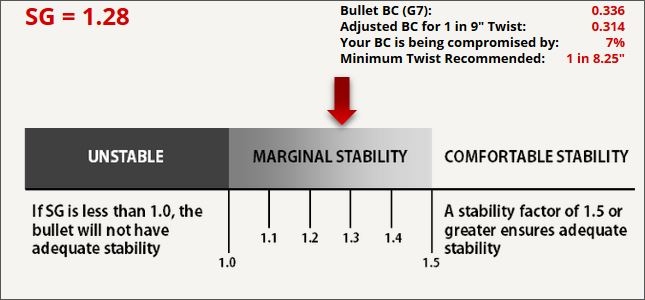Most things that fly through the air like rockets, missiles, airplanes, etc. use fins to achieve stability. The fins, or tail, move the center of pressure behind the center of gravity. This configuration is known as statically stable.
The general definition of stability, as it refers to flight, is that if the axis of the flight vehicle/projectile is disturbed, it will naturally re-align its axis with the direction of flight. In other words, it will naturally weather-vane into the oncoming airflow.
Bullets, lacking fins or a tail, are statically instable which means the center of pressure is in front of the center of gravity. Bullets achieve stable flight by spinning, and creating rigidity out of the rotating mass adequate to resist the aerodynamic instability. In order to achieve true gyroscopic stability, a bullet must be spun fast enough. This is why it’s important to know your barrel twist rate and the twist rate requirements of any bullet you’re considering. Don’t spin the bullet fast enough, and it will not fly with it’s full potential Ballistic Coefficient (BC) performance (due to excessive wobble). If the twist is way too slow for the bullet, it can completely tumble in flight.
What many shooters don’t fully grasp is the gray area of marginal stability where you may be shooting good groups with round-looking holes in paper, but the bullet is actually flying with some minor wobble that’s diminishing the effective BC.
Gyroscopic stability is described by the stability factor: specific gravity (SG). Mathematically SG is the ratio of the stabilizing influences of rotating mass, vs. the de-stabilizing effects of aerodynamics. If this ratio is greater than 1.000, it means the bullet has more stabilizing influence than de-stabilizing influence, so it’s said to be stable. In practice, a bullet needs an SG of 1.5 or greater to be well stabilized, and fly with the maximum effective BC.
Bullets with an SG stability of less than 1.5 will produce a “lower than advertised” BC downrange, and have a higher shot-to-shot BC variation. These inconsistencies will equate to a larger vertical dispersion at long range.
Because stability is so important to a bullets flight performance, Berger hosts a Twist Rate Stability Calculator on our website. Using this tool, shooters are able to determine which bullets are viable in their rifle barrel (twist rate), even accounting for environmental conditions.
The twist rate calculator becomes important especially when considering the trend towards longer, heavier-for-caliber, high BC bullets being offered by many manufacturers. It’s common (with some other brands) to release such bullets without providing adequate information about the special twist requirements. As a result, shooters often get poor performance and don’t always understand why. Unfortunately the marketing departments are inclined to recommend standard twist rates to appeal to more potential buyers. The sad result is disappointment when the advertised super high BC’s are not realized in the twist rates recommended for the bullets.

When shooting a 6.5mm 144gr LRHT bullet out of a 1:9″ twist barrel, it may still shoot good groups, but your BC will be reduced by nearly 7%!
At Berger, as always, it’s far more important to us that the shooters have the correct technical data to make best use of our product, which is why we provide the twist rate stability calculator. If the calculator suggests that one of our high BC bullets requires a twist rate that’s faster than standard, then that’s the reality, and our customers can make informed decisions even if it indicates that bullet won’t work in your twist. The calculator also can recommend other bullets that will work in your specified twist, so you can see the best options available which will fully stabilize in your rifle.
One myth related to BC and stability warns of the consequences of over-stabilizing bullets with too fast of a twist. The myth states that: spinning a bullet too fast can cause excessive stability and prevent the bullet from tracking with the trajectory, so it falls ‘nose-high’ on the downrange end, and causes more drag. This myth is easily dispelled if you recall the definition of stability, which is that the projectile aligns with the oncoming air flow. It does this even as the trajectory bends, and even for high SG’s obtained with fast twist. In fact, doppler radar data consistently shows that faster twist and higher SG’s actually reduce drag, especially at transonic speed for bullets fired at long range. The myth warning of overstability stems from high angle artillery fire where rounds could sometimes fail to track, and fall base first to the ground. This is not a problem in the realm of small arms rifle bullets shooting at small angles (under 30 degrees).
In summary, it is important to understand the twist rate requirements of any given bullet using a tool like our twist rate stability calculator, even if it is another brands’ bullet. This allows you to understand what the best bullet is for your rifle given your barrel’s twist rate, what twist rate barrel you should purchase for a new rifle, and to get the best possible down range results by matching those two factors together.
Want a bullet that has both a high BC and a consistent BC? Learn more about our new Long Range Hybrid Target bullets.
